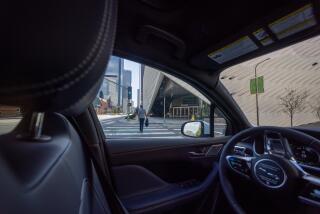Non-Crash Mishaps Most Risky to Child : Unrestrained Toddlers Often Thrown Out of Cars on Turns, UCI Researchers Write
- Share via
More children run the risk of being ejected from a car and seriously injured in a “non-crash” than in a typical accident, three UC Irvine researchers wrote in an article in this week’s issue of the Journal of the American Medical Assn.
“Those children who fell (from a car) or were ejected tended to sustain more multiple injuries, more extremity fractures, and a greater number of internal head injuries compared with those injured inside the vehicle,” the article says. The professional publication is considered the leading scientific journal of the American Medical Assn.
An example of such a “non-crash” incident would be a sharp turn that threw an unrestrained toddler against a car door that was not fully latched.
It is dangerous for people of all ages, particularly toddlers, to ride in cars without using safety restraints or seat belts, Dr. Phyllis F. Agran, assistant professor of pediatrics at UC Irvine Medical School, said in an interview Thursday.
The other authors of the article are Debora E. Dunkle, a research specialist with the university’s Public Policy Research Organization, and Diane G. Winn, research associate of the same organization.
Agran has testified in favor of a seat belt bill introduced by Assembly Speaker Willie Brown (D-San Francisco). Brown’s bill, which has cleared the Assembly, not only would require that seat belts be used, it would also require automakers to install air bags or other automatic protection devices in all new cars to be sold in California.
Another seat belt bill, sponsored by state Sen. John Foran (D-San Francisco), was rejected by the Senate in April but is up for reconsideration.
Supports Seat Belt Laws
The medical article said seat belt laws that apply to all ages, such as New York state’s, could be a “major factor” in eliminating such non-crash ejections and falls.
The three writers took a 12% sampling of motor-vehicle injuries to children between ages 1 and 14 reported to hospital emergency rooms in Orange County between April, 1980, and December, 1983. They found that of the total of 1,638 motor vehicle cases, 165 were non-crash injuries.
In the 45-month study period, they found that ejection of an unrestrained child from the car was more likely in a non-crash incident than in a crash.
“Only 4% of the children involved in a crash were ejected,” said Agran. “Whereas, 44% of the children in a non-crash were ejected.”
Each year in the United States, about 150,000 children under 15 are reported injured or killed in motor vehicles. The researchers wanted to look at the less widely known statistics on the number of children injured in non-crash accidents because they are less likely to be reported to police.
“What’s so disturbing about this is, we feel this is almost 100% preventable by the use of appropriate car seats for infants and seat belts,” Agran said.
The high-risk youngsters are the toddlers and the adolescents. In the case of adolescents, most were injured while showing off. Agran said teen-agers tend to get hurt while riding in “non-passenger” locations, such as in the backs of trucks, or on car hoods.
Safer Inside the Car
In most cases resulting in serious injury to a child between 1 and 4, the child was unrestrained in the car. Typically, Agran said, the child falls against a door during a turn, falls out of the car and then risks being run over and killed.
“We found that if children stay in the vehicle--even during crashes--their injuries are less serious. What’s so disconcerting is there is a very high risk of being ejected,” she added.
The researchers noted that in addition to controlling the child’s behavior, parents or guardians must take responsibility for securing all restraints and car doors.
Families with toddlers also may choose a two-door vehicle, or one with child-proof locks, they said.
The research team recently received funds for a study on the effectiveness of the 1983 California Child Passenger Safety Act, requiring the use of child safety seats.





